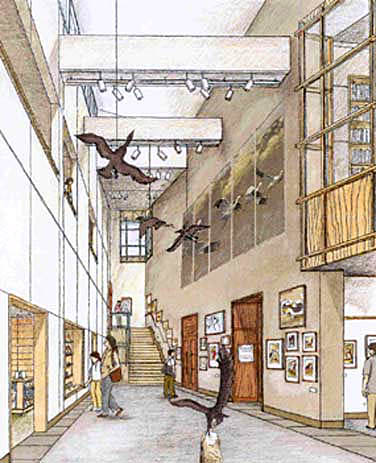$1.7 million grant from National Science Foundation will outfit multimedia visitors center in Cornell Lab of Ornithology's new facility
By Allison Wells

The Cornell Lab of Ornithology has topped off a successful fund-raising campaign for its new facility with a $1.7 million grant from the National Science Foundation (NSF). The grant will enable the lab to create, as part of the new building, a visitors center offering hands-on learning experiences, including multimedia "virtual bird walks."
Based on the theme "Understanding Birds," the NSF grant will help the lab provide interactive, multimedia learning stations to aid visitors with bird identification skills vital for understanding and appreciating birds and biological diversity. The exhibits also will provide the opportunity to learn field techniques and basic scientific methodology, including how scientists ask questions and arrive at conclusions.
Now under construction at the Sapsucker Woods sanctuary, north of Cornell University's central campus in Ithaca, the new building is scheduled for completion by spring of 2003. More than $32 million was raised by the ornithology lab for construction and other related projects. Additional information on the lab's programs and construction project can be found at http://birds.cornell.edu. The site soon will include a live web cam to document construction progress and the surrounding wildlife habitat.
"This NSF grant allows us to provide visitors to our building with unique, interactive experiences for learning about birds and other wildlife and also will encourage them to explore and test scientific concepts," says John Fitzpatrick, director of the lab and a co-author of the grant proposal. "Our goal will be to ensure that our visitors leave with a greater comprehension of birds and science and with the confidence to join in our research by becoming part of our continentwide network of citizen scientists." The centerpiece of the new visitors center exhibits will be the Sight and Sound Room, which will provide an audiovisual "virtual" experience with birds. This state-of-the-art room will be wired for surround-sound and will include video screens and other tools used for interactive learning. Users will have the option of learning how to count flocks of birds or how to conduct a bird census. They will be invited to take a virtual bird walk, with or without a "guide," and to appreciate what the dawn chorus sounds like in any number of different places around the world.
The Science Museum of Minnesota is partnering with the Cornell Lab of Ornithology in the development of the exhibits. Other learning stations will:
- engage users in the ways in which computers and the Internet are used by ornithologists;
- tie together extinction and the ways citizen science helps keep common birds common;
- encourage users of "The Bird Family Tree" to think like a scientist about ways different bird species are related, then engage the users in the techniques scientists use to find out if they are correct.
Exhibits in the new visitors center also will enable visitors to answer for themselves perhaps the lab's most frequently asked question, "What bird did I see?"
All of the exhibits will draw upon the lab's extensive resources, including the world's largest library of natural sound recordings, a growing array of video footage, an extensive collection of original artwork and several thousand photographic bird images. The lab also is a leader in citizen-science research, engaging birders of all ages and skill levels in scientific studies such as Project FeederWatch and the House Finch Disease Survey.
The lab's reputation has made it a must-visit destination each year for thousands of visitors from around the world. "For many of our visitors, it's enough just to be here in this place where sound recording was developed and where cutting-edge research continues to thrive," says Allison Wells, the lab's communications and outreach director and a co-author of the NSF grant proposal. "Nonetheless, we are eager to provide the kind of innovative learning experience the exhibits in the new visitors center will allow for."
All of the exhibits, including the Sight and Sound Room, will be designed for easy export to nature centers and educational institutions throughout the country. "We've forged some exciting relationships with education-based organizations interested in providing some of these exhibits at their facilities," says Rick Bonney, the lab's education director and a co-author of the grant proposal. "This vastly increases the educational value of the exhibits and is an extremely effective way to disseminate the lab's mission, to interpret and conserve the Earth's biological diversity." The current ornithology facility will remain open throughout the construction process. This includes the Wild Birds Unlimited store located in the observatory as well as most of the four-plus miles of hiking trails that wind through Sapsucker Woods sanctuary. Along with the new building, the lab will expand the 220 acres now devoted to wildlife habitat.
Media Contact
Get Cornell news delivered right to your inbox.
Subscribe